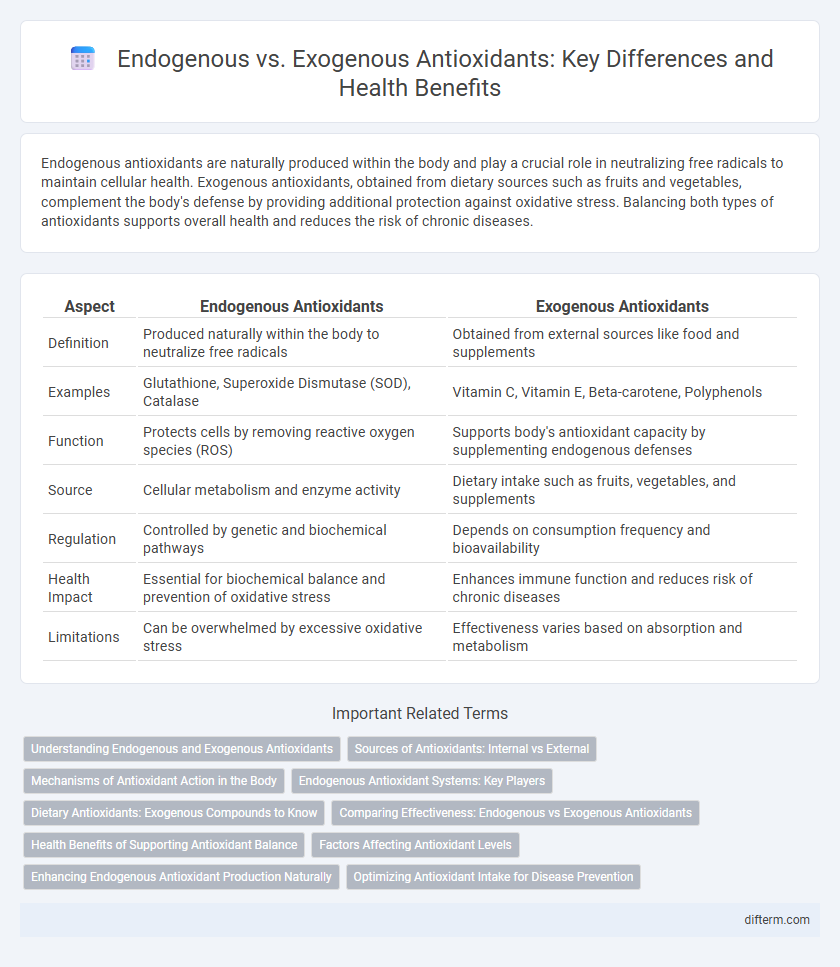Endogenous antioxidants are naturally produced within the body and play a crucial role in neutralizing free radicals to maintain cellular health. Exogenous antioxidants, obtained from dietary sources such as fruits and vegetables, complement the body's defense by providing additional protection against oxidative stress. Balancing both types of antioxidants supports overall health and reduces the risk of chronic diseases.
Table of Comparison
| Aspect | Endogenous Antioxidants | Exogenous Antioxidants |
|---|---|---|
| Definition | Produced naturally within the body to neutralize free radicals | Obtained from external sources like food and supplements |
| Examples | Glutathione, Superoxide Dismutase (SOD), Catalase | Vitamin C, Vitamin E, Beta-carotene, Polyphenols |
| Function | Protects cells by removing reactive oxygen species (ROS) | Supports body's antioxidant capacity by supplementing endogenous defenses |
| Source | Cellular metabolism and enzyme activity | Dietary intake such as fruits, vegetables, and supplements |
| Regulation | Controlled by genetic and biochemical pathways | Depends on consumption frequency and bioavailability |
| Health Impact | Essential for biochemical balance and prevention of oxidative stress | Enhances immune function and reduces risk of chronic diseases |
| Limitations | Can be overwhelmed by excessive oxidative stress | Effectiveness varies based on absorption and metabolism |
Understanding Endogenous and Exogenous Antioxidants
Endogenous antioxidants, produced naturally within the body, include enzymes such as superoxide dismutase, catalase, and glutathione peroxidase that neutralize free radicals and protect cells from oxidative stress. Exogenous antioxidants, obtained through diet, consist of vitamins C and E, carotenoids, and polyphenols, which complement the body's defense by scavenging harmful reactive oxygen species. Understanding the balance between endogenous and exogenous antioxidants is essential for optimizing cellular health and preventing chronic diseases linked to oxidative damage.
Sources of Antioxidants: Internal vs External
Endogenous antioxidants such as glutathione, superoxide dismutase, and catalase are produced internally by the body to neutralize free radicals and combat oxidative stress. Exogenous antioxidants, found in external sources like fruits, vegetables, nuts, and dietary supplements, complement the body's defense by providing additional protection through vitamins C, E, and polyphenols. Balancing both internal enzymatic antioxidants and external nutrient intake is essential for maintaining optimal cellular health and preventing chronic diseases linked to oxidative damage.
Mechanisms of Antioxidant Action in the Body
Endogenous antioxidants, such as glutathione and superoxide dismutase, neutralize free radicals by enzymatically converting reactive oxygen species into less harmful molecules within cells. Exogenous antioxidants, including vitamins C and E, scavenge free radicals by donating electrons, thereby preventing oxidative damage to cellular components. Both mechanisms protect against oxidative stress by maintaining redox balance and supporting cellular repair processes in the body.
Endogenous Antioxidant Systems: Key Players
Endogenous antioxidant systems play a crucial role in protecting cells from oxidative stress by neutralizing free radicals internally. Key players include enzymes such as superoxide dismutase (SOD), catalase, and glutathione peroxidase, which work synergistically to dismantle reactive oxygen species (ROS). These intrinsic defense mechanisms maintain cellular integrity and support immune function by preventing oxidative damage linked to aging and chronic diseases.
Dietary Antioxidants: Exogenous Compounds to Know
Dietary antioxidants, classified as exogenous compounds, play a crucial role in neutralizing free radicals and reducing oxidative stress in the body. Key examples include vitamins C and E, carotenoids, and polyphenols found in fruits, vegetables, nuts, and whole grains, which support cellular health and prevent chronic diseases. Understanding the bioavailability and synergistic effects of these antioxidants enhances their efficacy in boosting the body's defense system against oxidative damage.
Comparing Effectiveness: Endogenous vs Exogenous Antioxidants
Endogenous antioxidants, such as glutathione and superoxide dismutase, provide continuous cellular defense by neutralizing reactive oxygen species (ROS) produced during metabolic processes, ensuring ongoing protection and cellular repair. Exogenous antioxidants, including vitamins C and E, polyphenols, and carotenoids, supplement this defense by scavenging external free radicals and reducing oxidative stress from environmental factors like pollution and UV radiation. Studies demonstrate endogenous antioxidants maintain superior effectiveness in preventing oxidative damage due to their localized enzyme activity and regeneration capacity, whereas exogenous antioxidants offer essential support but often require dietary intake or supplementation for optimal levels.
Health Benefits of Supporting Antioxidant Balance
Endogenous antioxidants, produced naturally by the body, play a crucial role in neutralizing free radicals to maintain cellular health and reduce oxidative stress. Exogenous antioxidants, sourced from fruits, vegetables, and supplements, complement this defense by replenishing antioxidant levels and enhancing immune function. Supporting a balanced intake of both endogenous and exogenous antioxidants promotes optimal health by preventing chronic diseases and enhancing cellular repair mechanisms.
Factors Affecting Antioxidant Levels
Antioxidant levels are influenced by a variety of factors including diet, age, genetic predisposition, and environmental exposures. Endogenous antioxidants, such as glutathione and superoxide dismutase, depend heavily on metabolic efficiency and nutritional status to maintain optimal activity. Exogenous antioxidants, like vitamins C and E obtained from fruits and vegetables, fluctuate with dietary intake and lifestyle choices, while exposure to pollutants and oxidative stress can deplete both types, impacting overall oxidative balance.
Enhancing Endogenous Antioxidant Production Naturally
Enhancing endogenous antioxidant production naturally involves boosting the body's internal defense mechanisms against oxidative stress through nutrient-rich foods and lifestyle choices. Consuming foods high in polyphenols, such as berries, green tea, and dark leafy greens, activates the Nrf2 pathway, which regulates the expression of antioxidant enzymes like glutathione peroxidase and superoxide dismutase. Regular physical activity and adequate sleep further support endogenous antioxidant systems, optimizing cellular resilience and reducing the reliance on exogenous antioxidant supplements.
Optimizing Antioxidant Intake for Disease Prevention
Optimizing antioxidant intake involves balancing endogenous antioxidants like glutathione and superoxide dismutase with exogenous sources such as vitamins C and E from diet or supplements. Endogenous antioxidants provide crucial cellular defense against oxidative stress, while exogenous antioxidants enhance this protection by neutralizing free radicals before they damage cells. Targeted consumption of antioxidant-rich foods, including berries, nuts, and green leafy vegetables, supports synergistic action and reduces the risk of chronic diseases like cardiovascular disease, cancer, and neurodegenerative disorders.
Endogenous vs Exogenous antioxidants Infographic

 difterm.com
difterm.com